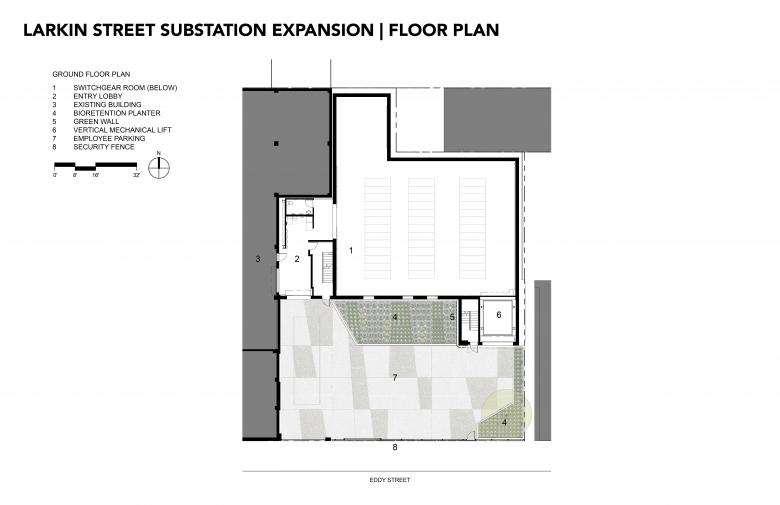US Building of the Week
Larkin Substation Expansion
TEF Design
18. Juli 2022
Photo © Mikiko Kikuyama
A faceted facade and lush green wall make this extension to an electrical substation a good neighbor in San Francisco's Tenderloin neighborhood. The architects at TEF Design answered a few questions about the project.
Location: 538 Eddy Street, San Francisco, California, USA
Client: PG&E
Architect: TEF Design
- Design Principal: Andrew Wolfram, AIA, LEED AP BD+C, LFA
- Project Architect: Justin Blinn, AIA, LEED AP BD+C, LFA
- Project Manager: Paul Cooper, AIA, LEED AP BD+C
MEP/FP Engineer: MHC Engineers, Inc.
Landscape Architect: Creo Landscape
Lighting Designer: HLB Lighting
Utility Consultant/Owners Representative: Urb-in
Contractor: Plant Construction Company, LP
Site Area: 46,875 sf
Building Area: 12,000 sf
Important Manufacturers / Products:
- Landscape Wall: GSky
- Photovoltaic System: Sun Light & Power
- Exterior Lighting: Ecosense, Luminii, iLight, Bega, Hydrel, Cree
- Rainscreen: Nvelope
- Fiber Reinforced Polymer Panels: Kreysler & Associates
Photo © Mikiko Kikuyama
What were the circumstances of receiving the commission for this project?The client issued an RFP (Request for Proposals). TEF submitted a proposal and was selected for the commission.
Photo © Mikiko Kikuyama
Please provide an overview of the project.Tucked mid block on Eddy Street between Larkin and Hyde, in San Francisco’s famously gritty Tenderloin neighborhood, the 12,200-square-foot expansion to an historic 1962 electrical substation represents a couple of “firsts” in environmental stewardship. Housing critical electrical infrastructure as well as storage and support space, the one-story-plus-basement addition also features a faceted facade and lush green wall that lend welcome aesthetic relief to the otherwise gritty urban fabric of the surrounding neighborhood.
Photo © Mikiko Kikuyama
What are the main ideas and inspirations influencing the design of the building?The building’s design was inspired by the city’s power grid and shaped by the aspiration to be a sustainable, net zero energy development and asset to the neighborhood.
The building features rainscreens that integrate three types of individually modeled glass-fiber-reinforced-polymer (GFRP) panels. Together, they form a faceted facade — an abstraction of the substation’s service area — that casts ever-changing shadow patterns across its surface throughout the day and year. At night, sloped panels embedded with light fixtures pulsate across the building, expressing the city’s dynamic electrical power grid. The lighting also enhances safety and security within and around the project. To reduce light pollution to the largely commercial and residential surroundings, the design team directed light downward onto the facade and site.
Photo © Mikiko Kikuyama
How does the design respond to the unique qualities of the site?The constrained property and need to accommodate crane and equipment lift access prescribed the project’s perpendicular orientation to the existing substation. A west-facing green wall, planted in a geometric pattern that echoes the faceted facade, provides biophilic relief to the urban block while advancing the client’s commitment to enhancing the community.
Photo © Mikiko Kikuyama
Was the project influenced by any trends in energy-conservation, construction, or design?The project is the first NZE (Net Zero Energy) targeted electrical substation building in the United States and the first NZE electrical switchgear building to get a rating from the International Living Future Institute’s (ILFI) Zero Energy Building (ZEB) Certification™ of the Living Building Challenge.
The project had a primary goal of achieving zero net energy for the base building (not including process energy) by limiting space conditioning and lighting energy use in particular. To achieve this, a low-energy approach to space conditioning was utilized: fresh, filtered, outside air was brought into the space and then through natural convection (aided by strategically located exhaust fans at the roof and first floor) ambient air temperature is maintained within optimal ranges for the equipment. Additionally, high efficiency LED lighting is utilized throughout, including at the exterior. The combined energy load is then offset by on-site, 60-kw solar panel arrays located on the roof of the building.
Lastly, to comply with the city's stormwater control requirements, two bioretention planters are located at grade (both roof and site runoff is directed to these planters) along with a vertical green wall which additionally brings a moment of biophilia to the urban location.
Email interview conducted by John Hill.
Drawing: TEF Design
Drawing: TEF Design
Drawing: TEF Design
Drawing: TEF Design
Drawing: TEF Design
Drawing: TEF Design
Verwandte Artikel
-
Larkin Substation Expansion
18.07.22
-
Data Moire
21.04.17











